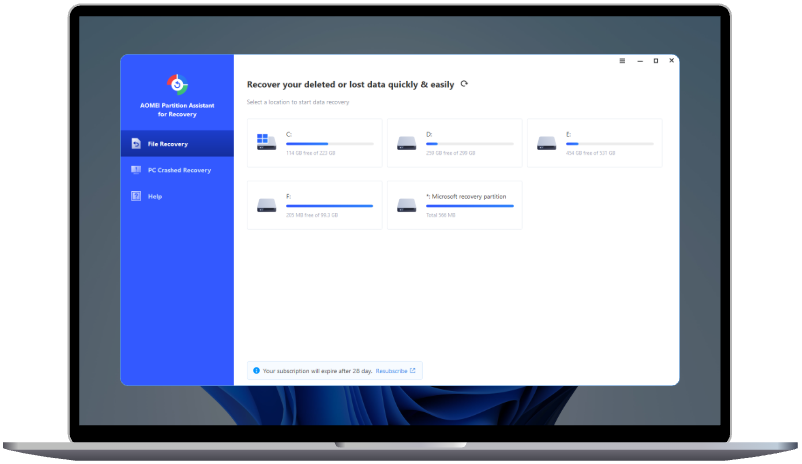How to Fix Show File And Folders With 0KB in Windows 11, 10, 8, 7?
This tutorial will guide you to fix or recover show files and folders with 0KB. You can easily fix the issue and recover any lost data.
Why does show files and folders with 0KB?
If you’ve ever opened a folder and found that some files are showing as 0KB in size, you’re not alone. This issue happens more often than you might think. A 0KB file means that the file exists, but it has no data inside—it’s basically empty. This can be frustrating, especially if the file once held something important.
To fix this issue properly, it’s important to first understand what caused it. Files can turn into 0KB for several reasons, such as errors during downloading, virus attacks, or even software bugs. By knowing the cause, you’ll have a better chance of recovering your lost data.
Below are some of the most common reasons why files show as 0KB.
-
A virus or malware attack damaged the files.
-
The file you uploaded or downloaded had an unsupported format or attribute.
-
The upload or download didn’t finish properly.
-
You received incomplete files through email or as attachments.
-
Some 0KB files are created on purpose by certain programs or users.
Now that you know what might have caused your files to turn into 0KB, you can move on to the next part to find the best way to fix them.
How to repair 0KB file in Windows 11, 10, 8, and 7?
There are 4 fixes can help you remove or repair 0KB file and folder in Windows 11, 10, 8, and 7. You can also recover any lost data before attempting other methods.
Fix 1. Recover 0KB files and folders
If a file becomes 0KB, it often means the file is damaged or corrupted. In this case, using file repair or recovery software can help fix the problem. One useful tool is AOMEI Partition Assistant for Recovery. It can repair broken Word or Excel files and also fix corrupted photos and videos.
Sometimes, even after removing a 0KB virus, your files may still not show up on your computer or external drive. When this happens, it's a good idea to try professional data recovery software to get your files back.
Data loss can also happen for other reasons like accidental deletion or formatting. No matter the cause, using a reliable file recovery program is often the best way to recover your data. AOMEI Partition Assistant for Recovery makes the recovery process simple and easy. You can restore files in just few quick steps.
Step 1. Install and launch AOMEI Partition Assistant for Recovery. Choose the exact partition or disk where your data lost and click Scan.
Step 2. Then, the recovery tool start to scan and search. lt will execute the “Quickly Scan" first for finding your deleted data fast, and then execute the “Deep Scan" for searching other lost data.
Step 3. Once the scan is completed, all deleted files, recycle bins and other missing files will be displayed. Please select the file you would like to recover and then click "Recover".
Step 4. Then, select a folder path to save your recovered files.
Step 5. Wait patiently for this process of recovering ends.
Fix 2. Remove 0KB virus from PC
If your .exe files or programs suddenly show 0KB, a common cause is a virus infection—often called the "0KB virus." This type of virus can damage your files and make them unreadable.
To fix this, you should use antivirus software to scan and remove the virus. There are many trusted antivirus tools available online that can help clean your system. Simply search for a reliable virus removal tool to get started.
Fix 3. Check the disk
If your files show 0KB due to a damaged file system, you can try using Command Prompt (CMD) to fix the issue. One common method is running the CHKDSK command, which helps repair file system errors like “disk structure is corrupted and unreadable.” However, keep in mind that this method might cause complete data loss. Here's how to do it step by step:
Step 1. Click the Start menu and type cmd in the search bar. Right-click on Command Prompt and select Run as administrator.
Step 2. In the Command Prompt window, type the following command and press Enter: CHKDSK F: /f /r /x
(Make sure to replace F: with the drive letter of your affected disk.)
Running this command will check the drive for errors and try to fix any issues causing your files to show 0KB. After the process is complete, your files may become usable again.
Fix 4. Show hidden files and folders
At times, a virus infection can cause your files to disappear and be replaced with empty 0KB files. In reality, your files might still be there—they’re just hidden.To see if that’s the case, try this method to unhide hidden files on your device:
Step 1. Open File Explorer from the taskbar, and select the “Layout and view options” icon. It’s the second icon from the right in the top menu.
Step 2. Press “Show.” And then choose “Hidden items”.
Then, the hidden files will now become visible in File Explorer.
Conclusion
It is annoying that show files and folders with 0KB, but it’s a pretty common issue. The good news is that there are several ways to deal with it—whether it’s using recovery software like AOMEI Partition Assistant for Recovery, scanning for viruses, or just checking if the files are hidden. Once you figure out what caused the problem, you’re in a much better position to fix it and hopefully get your files back.

